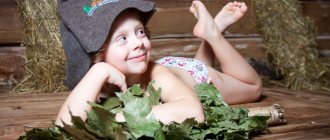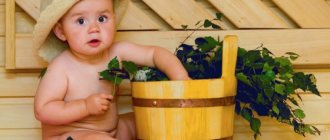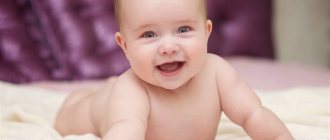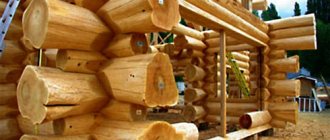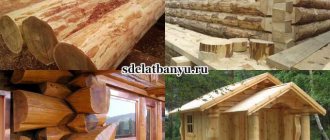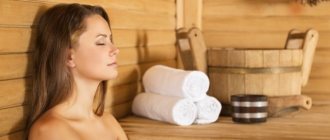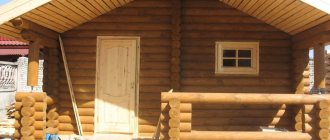From time immemorial in Rus', women gave birth in a bathhouse (and not only commoners, but also noblewomen, princesses and even queens).
By the way, modern medicine, as often happens, has confirmed that our ancestors had many reasons for this. There is a lot of warm water in the bathhouse, the right air temperature (which is suitable not only for the mother in labor, but also for the newborn baby), and hot steam kills pathogenic microbes. And from birth, the bathhouse accompanies a person all his life - the bathhouse soars, the bathhouse rules, the bathhouse will fix everything, people say.
At what age can a child go to the bathhouse?
The healing effect of bath procedures is achieved due to the temperature difference, as well as due to the moist, hot air of the steam room.
All these conditions are well tolerated by most adult bath-goers, but children must first be prepared for visiting the sauna and steam room. If you want to introduce your child to the bathhouse, then you should wait until he reaches 3 years of age. The body of a newborn baby is characterized by imperfect thermoregulation - it quickly overheats and reacts negatively to high temperatures. This feature persists in children until about one and a half years old: at this time, parents should take care that the child is not hot or cold, and use water at 37-38°C for hygiene procedures. After one and a half years, you can begin to gradually harden the child, but this should not be done in a bathhouse. In addition, children under three years of age have not yet developed sweat glands, so visiting the steam room may not be safe for them. All pediatricians agree that from the age of three, visiting a bathhouse is absolutely safe, and before this age you can harden your baby using air baths and wet rubdowns. The most famous children's doctor, the famous doctor Evgeniy Komarovsky, shares the same opinion.
A child over three years old can visit the bathhouse with their parents, but the time spent in the steam room should be limited to a few minutes. In this case, the temperature in the steam room should not exceed 40°C, and the baby’s condition must be carefully monitored. After warming up, you can pour cool water over the child’s hands and feet, and then continue hygiene procedures in the shower or wash room.
Contraindications
You should not resort to the help of a steam room if the child has disturbances in the functioning of vital organs and systems. The following are contraindications:
- Malfunctions of the heart and blood vessels, with or without the development of characteristic symptoms.
- Pathologies of the nervous system, high intracranial pressure, the presence of brain cysts.
- General weakness of the body, unpreparedness for changes in temperature conditions.
- The presence of diseases of viral, cold or infectious origin.
- Skin infections, furunculosis, dermatitis, eczema, diaper rash.
- Diseases of the respiratory system.
When visiting the bathhouse, the child should not experience any unpleasant phenomena. His skin is pink in color, sweat is allowed, but it is moderate in nature. If the baby sweats profusely, it is better to take him out of the steam room, as there is a risk of dehydration.
If the baby's skin changes color - it becomes blue or too pale - immediately leave the steam room and monitor the condition. If necessary, call an ambulance. When it comes to a bath and a child in his first year of life, you should be careful. Such procedures can cause overheating and negatively affect the baby’s health.
Is it possible to wash a child in a bath?
A modern bathhouse is a multifunctional building, often equipped not only with a steam room and a wash room, but also with a separate shower room. If your bathhouse is like this, then you can fearlessly take your children with you and wash them in the bathhouse.
During hygiene procedures, it is necessary to ensure the safety of children:
- Protect the stove and other heating devices;
- Place non-slip mats on the floor and shelves;
- Monitor the air temperature in the room;
- Control the time spent in the steam room.
If you use a special baby bath to bathe your baby, then it must be installed and fixed on a flat surface at a low level. Fill the bath with water yourself and check its temperature with a thermometer. Choose products for washing your baby’s hair and body based on his skin type and the pediatrician’s recommendations. If the baby is in the bathhouse for the first time, then it is advisable for parents to hold him in their arms so that the child can quickly adapt to the new environment and feel safe. Take with you an inflatable ring, a hat or your baby’s favorite toys, and bathing will turn into pleasant entertainment.
If the bathhouse is located at a distance from living quarters, then after washing, dress the baby in warm clothes, or wrap him in a blanket or blanket. A towel made of natural linen or cotton will help quickly remove moisture from your child's skin.
How to properly care for children under 1 year old
Hygiene guards our health, protecting us from infections and diseases, including skin diseases. During the first time after birth, the mother takes care of the baby’s hygiene.
We wrote in detail about how to care for a newborn here. Continue to follow the same pattern of baby care until you teach your child to take care of himself - and don't forget about supervision!
The list of all necessary products for hygiene procedures for children of this age remains the same as for a newborn. Let us remind you what is included in it.
Basic baby hygiene items (up to 1 year):
- Diapers (disposable, reusable);
- Diapers (disposable, waterproof, flannel);
- Baby bath;
- Bathtub insert for bathing / slide into the bathtub / seat;
- Soft towels;
- Baby soap and shampoo for bathing;
- Soft mitten (or sponge) for bathing;
- Baby cream;
- Diaper rash cream;
- Baby oil;
- Cotton wool, cotton pads and balls for hygiene procedures;
- Cotton swabs with stops for cleaning the auricle;
- Wet wipes for quick care;
- Children's scissors/tweezers with rounded ends/nail file;
- Thermometer;
- Nasal aspirator;
- Syringe No. 1 with a soft spout;
- Gas outlet tube;
- Heating pad to relieve abdominal pain;
- Pipette with a round end;
- Hair brush;
- Children's washing powder;
- First aid kit:
- Hydrogen peroxide 3%;
- Brilliant green solution 1%;
- Chlorophyllipt solution;
- Iodine;
- Tincture of calendula;
- Herbs for bathing - chamomile, string, oak bark, motherwort, valerian, mint, lemon balm, lavender, pine needles.
In the second year of life, the list expands. Children's hygiene items from 1 year to 4 years (in addition to the previous ones):
- Pot;
- Toothbrush;
- Toothpaste;
- Comb;
- Face towel;
- Towel for intimate hygiene;
- A bath towel;
- Bathing sponge;
- Bath foam;
- Bathing gel;
- Sunscreen;
- Fat cream.
So, what should you do to maintain normal skin and mucous membranes and improve your baby’s overall health?
A baby's morning toilet looks the same as an adult's: he washes himself. During the day and evening, the child will remain clean and well-groomed (at first with the help of an adult caring for him), performing seemingly simple procedures that you will teach him that are no longer noticeable to the parents.
Is it possible for children to take a steam bath?
The Russian bath and Finnish sauna have a powerful healing effect: visiting a steam room and steaming with brooms is often used as a therapeutic and prophylactic procedure to help prevent or cure colds in children. However, parents must remember an important rule - only completely healthy children can visit the bathhouse! Contraindications to bath procedures are also:
- Heat;
- Presence of skin rash;
- Diseases of the blood, kidneys and thyroid gland;
- Frequent nosebleeds;
- Manifestations of vegetative-vascular dystonia.
Before your first visit to the bathhouse, you must consult your doctor and get his approval for this procedure.
Children as young as five years old can steam with brooms, of course, with the help of their parents. And even in this case, the procedure should be carried out at the child’s request: if the baby refuses to take a steam bath, do not insist on the procedure. In this case, simply having the child in the steam room will have a beneficial effect: the aroma of steamed brooms and herbs acts as an inhalation and helps to heal the body.
For children, it is better to choose brooms with small soft leaves - the best option would be a traditional birch or linden broom. Rinse thoroughly, and then steam the broom in hot water, and before use, be sure to shake off excess moisture. You can also heat a wet broom on a heater for a short time.
You need to steam your baby gently and not intensely: pay special attention to the baby’s legs and arms, and just gently stroke the surface of the back and abdomen with a broom. During the procedure, carefully monitor the child’s well-being and mood, and at the slightest fatigue, weakness or malaise, immediately take him out into the fresh air or into a cool room.
Post-bath care for children from 1 month to 1 year: skin, eyes, ears, nose, nails
After bathing, the baby's skin must be thoroughly dried, paying special attention to the hair, ears, eyes, folds and folds.
- The outer side of the auricle can be wiped with a towel, and dry the inner side (not the ear canal!) with a cotton swab.
- You can do the same with your nose. If he sniffles, first use an aspirator (or a baby syringe with a soft spout No. 1) to remove anything from the nasal passage that is making breathing difficult. If there are crusts inside, drop a drop or two of breast milk into your nose, wait until they soften, and carefully remove them with a cotton swab.
- It is enough to wipe the eyes with a cotton pad moistened with boiled water (we repeat this procedure in the morning, after waking up).
It is better to use cotton swabs with limiters for cleaning the inner shell of the ears no earlier than the baby turns 1 year old.
Give your baby an air bath
If the child does not show anxiety and impatience due to the fact that he is hungry, you can give the completely dry baby 10 - 20 minutes of air baths (make sure that the room temperature is not lower than 20 - 22 ° C). This way you will give your baby’s skin a chance to breathe, take a break from diapers, restore its natural protective layer after bathing, and at the same time carry out a simple hardening procedure. Air baths are a necessary condition for the prevention of diaper dermatitis.
How to prepare your baby for a sauna or steam room?
Warming up in a steam room and steaming with brooms is the final stage of hygiene procedures in a bathhouse or sauna. To ensure that your stay in the steam room brings maximum benefits, wash your baby first and make the water for rinsing the body a little colder than the child’s usual temperature.
The first entry into the steam room should be short and not exceed one minute. Adaptation to the heat of the sauna may take several months: during this time, the duration of stay in the steam room should not be increased, and one visit to the steam room will be enough. When the child’s body adapts to temperature stress, you can visit the bathhouse once a week, and spend no more than three minutes in the steam room.
Before visiting the bathhouse, the baby needs to be given something to drink, but the last meal should be no later than 2 hours before the water procedures. It is recommended to take berry juice, tea without sugar or a decoction of herbs with you to the bathhouse - this way you will prevent dehydration of the child’s body and you can give him a tasty healthy drink.
What is better - a bathhouse or a sauna?
It is believed that the dry air of a Finnish sauna is easier to tolerate for adults, but high temperatures are undesirable for children. Therefore, it is better to accustom a child to a bath with visits to a traditional Russian steam room. At the same time, you should not overheat the room, and before bathing procedures it is advisable to thoroughly ventilate the steam room. In the steam room, it is necessary to maintain the temperature no higher than 50°C, monitoring it using thermometer readings.
Children over seven years old can visit the sauna with their parents, independently choosing the time they spend in it, but the period of adaptation to high temperatures should also not be forgotten.
Introduction
Lipids play an important role in ensuring the full function of the skin, therefore, traditionally, animal and plant oils, as well as mineral oil, were used for skin care, including for newborns. Various oils are also used in the production of most skin care products, but the issue of the advantages and disadvantages of oils of different origins is still actively debated. Skin care practices for newborns and infants vary and are largely dependent on cultural traditions and the subjective experiences of parents and healthcare professionals. In 2016, European skin care guidelines based on evidence-based clinical research were published. According to modern recommendations, skin care practices should ensure the preservation of the skin, the physiological adaptation of the skin barrier of newborns to environmental conditions, and protect against skin contact with potentially toxic substances [1].
Precautions in the bath
The special microclimate of baths and saunas can have both a healing effect and cause harm to the child’s body if the simple rules of behavior in the bath are neglected. The most important commandment for parents is not to leave their children in the bathhouse unattended, and to constantly monitor their appearance and well-being. Bathing procedures must be stopped immediately if you notice at least one of the following signs:
- The child's face suddenly turned pale or red;
- The baby's nasolabial triangle has acquired a bluish tint;
- The child's hands and feet became cold;
- The child has nausea or vomiting;
- The baby becomes lethargic or complains of dizziness.
All these changes are a consequence of overheating of the body, so the main thing in this situation is to take the baby out into the fresh air and try to cool his skin. The best way to eliminate overheating is a cold compress from a damp towel placed on the child's forehead. Also pour cold water over the arms and legs, provide the baby with peace and seek help from a pediatrician.
To prevent possible injury, do not allow children to:
- Run and jump;
- Open hot and cold water taps independently;
- Climb onto high shelves;
- Turn on heating devices;
- Open windows and doors to the room.
In case of injuries or deterioration in the health of bathhouse visitors, keep a first aid kit in the room, which should include:
- Ammonia;
- Hydrogen peroxide;
- Iodine or any other antiseptic drug;
- Bandages and cotton wool.
How to harden a child in a bath?
For many parents, visiting the bathhouse is inseparable from the process of hardening their babies. Indeed, in a warm, heated bathhouse, the effects of cold are tolerated much more easily. You can start hardening procedures from the age of five, and the best start to hardening will be foot baths. Fill two basins or buckets with warm and cool water and alternately dip your baby's feet in them. Complete the procedure with colder water, and then thoroughly dry your baby’s feet.
You should start hardening only after consulting a pediatrician, and when performing the procedure, you must strictly adhere to the doctor’s recommendations. If in the summer your child swims in open water or visits a pool, then he will easily and painlessly adapt to hardening baths. When carrying out hardening procedures, it is important to observe regularity and gradually lower the water temperature.
We hope our article has given a clear answer to your question - is it possible to bathe a child in a bathhouse, and you can instill in your children another healthy habit! Visiting the bathhouse for children helps them strengthen the body's defenses and be less likely to get colds. Follow our advice, and your children will enjoy and benefit from going to the bathhouse with you!
